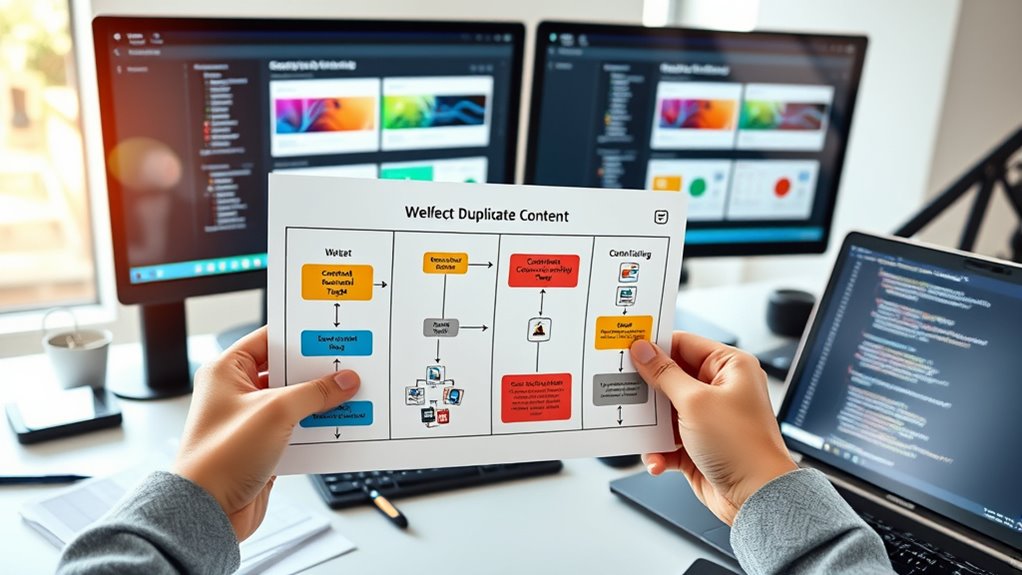To handle duplicate content effectively, use canonical tags to point search engines to your preferred versions, consolidating link equity and avoiding confusion. You can also implement noindex directives on pages you don’t want indexed, like print or archive versions. Managing URL parameters and using tools like Google Search Console helps prevent unintended duplicates. Combining these techniques with regular audits ensures your site maintains ideal SEO health. Continue exploring ways to master duplicate content management for better rankings.
Key Takeaways
- Use canonical tags to specify the preferred URL and consolidate duplicate content signals.
- Apply noindex tags on low-value or duplicate pages to prevent their indexing.
- Manage URL parameters via Google Search Console to reduce duplicate issues.
- Implement structured data to improve search engine understanding of your content.
- Regularly audit your site with tools like Screaming Frog to identify and resolve duplicates.
Understanding the Impact of Duplicate Content on SEO

While duplicate content might seem harmless, it can considerably harm your website’s SEO performance. Search engines prioritize content originality, so when they encounter identical or very similar pages, it becomes harder to determine which version to rank. This confusion can dilute your page authority, lowering your overall ranking impact. Duplicate content can lead to search engines indexing multiple versions of the same page, causing your site’s visibility to suffer. Additionally, it might result in your pages competing against each other in search results, making it more difficult for any one page to stand out. To protect your SEO efforts, it’s essential to understand how duplicate content can reduce your ranking potential and implement strategies to maintain content uniqueness. Understanding how to verify authentic sources, such as checking for brand reputation and official certifications, can help prevent unintentional duplication issues. Implementing canonical URLs and noindex tags are also effective techniques to control duplicate content and safeguard your site’s search engine performance. Utilizing AI content clusters can further assist in organizing your content effectively, ensuring relevance and reducing duplication across related topics. Additionally, employing necessary cookies to analyze user behavior can help identify sections of your website that may require content differentiation. Incorporating appliance testing and compatibility insights can also help ensure your content remains accurate and relevant, especially if your site discusses appliance safety and standards.
Using Canonical Tags to Indicate Preferred Content

To guarantee search engines recognize your main content, you need to place canonical tags correctly on your pages. This helps manage multiple versions of the same content and prevents SEO issues. Proper placement of these tags makes it clear which page is the preferred version, reducing duplicate content problems. Additionally, understanding how content discoverability works on platforms like TikTok can inform your SEO strategy for cross-platform visibility. When dealing with asset division in divorce proceedings, canonical tags can help organize related legal documents to avoid confusion and ensure clarity in online legal resources. Recognizing security measures and their importance can also aid in developing content strategies that address common user concerns and questions. Implementing structured data can further enhance how search engines interpret your content and improve your site’s visibility.
Proper Tag Placement
Have you ever wondered how search engines determine which version of your content to display? Proper tag placement is key. To guarantee your canonical tags are effective, follow these steps:
- Place meta tags, especially canonical tags, within the `` section of your HTML.
- Ensure header placement is consistent, so search engines easily identify your preferred URL.
- Avoid placing canonical tags in the body or footer, which can cause confusion.
- Incorporate mindful techniques like proper tag placement to improve your site’s SEO clarity. Additionally, implementing duplicate content management strategies helps search engines understand your content hierarchy and avoid indexing issues. Understanding indexing behavior can further optimize how your content appears in search results, especially when combined with the use of canonical tags and other techniques. Proper tag placement also ensures that your content adheres to SEO best practices, enhancing visibility and avoiding potential ranking penalties.
Managing Multiple Versions
Managing multiple versions of your content is vital for ensuring search engines understand which page to prioritize. Using canonical tags helps with content consolidation and effective version control, signaling the preferred page. Proper implementation prevents duplicate content issues and directs link equity to the right URL. For example, if you have duplicate product pages or localized versions, a canonical tag clarifies your main version. Here’s how different scenarios compare:
| Scenario | Canonical Tag Usage | Purpose |
|---|---|---|
| Duplicate product pages | `` | Indicate primary product |
| Multiple language versions | Canonical to main language page | Consolidate content |
| Printer-friendly pages | Canonical to original article | Preserve SEO value |
| Archived content | Canonical to current version | Maintain relevance |
This approach streamlines content management, enhances SEO, and guarantees your preferred content gets the visibility it deserves. Implementing content management best practices ensures your website remains organized and effective in search rankings. Additionally, understanding how canonicalization works can help prevent issues with duplicate content and improve overall site authority. Recognizing the importance of employing canonical tags correctly is essential for maintaining a strong SEO strategy and avoiding potential penalties related to duplicate content. Proper use of canonical tags also aids in reducing confusion among search engines by clearly indicating the primary version of similar or duplicate pages.
Implementing Noindex Directives to Manage Duplicate Pages

Implementing noindex directives is an effective way to control which pages search engines include in their index, helping you manage duplicate content more efficiently. By adding meta tags or robots directives, you tell search engines explicitly not to index certain pages. This is especially useful for duplicate pages, staging sites, or low-value content. Use the following steps:
Controlling search engine indexing with noindex helps manage duplicate content effectively.
- Add a `` tag to the head section of duplicate pages.
- Configure robots.txt files to disallow indexing of specific URLs.
- Avoid using noindex on important pages that should rank, and verify changes via search engine tools.
- Understanding canonical tags can also help consolidate duplicate content and ensure search engines recognize the primary version.
- Regularly monitor your site’s indexation status to ensure that only desired pages are included in search results. Additionally, leveraging internal linking strategies can help guide search engines to prioritize your primary content over duplicates. Being aware of duplicate content issues and how to address them is crucial for maintaining SEO health. Implementing structured data can further enhance how search engines interpret your site’s content and reduce potential confusion caused by duplicates. These methods guarantee search engines focus on your primary content, reducing duplicate issues and improving SEO clarity.
Differentiating Between Duplicate Content Types and Their Solutions

Understanding the differences between exact duplicates and near duplicates helps you choose the right solution. You also need to recognize whether duplication occurs internally within your site or externally from other sources. By identifying content variations and applying targeted strategies, you can effectively address each type of duplication. For example, Vetted – Halloween Product Reviews offers insights into product-specific content that can help you differentiate your site’s offerings. Additionally, understanding AI in Education can inform how personalized content is generated and how to avoid unintentional duplication. Recognizing the importance of content uniqueness is vital for maintaining your site’s authority and search engine rankings.
Exact Duplicates vs. Near Duplicates
Have you ever wondered how search engines distinguish between exact duplicates and near duplicates? Understanding this difference is key to effective duplicate detection and content management. Exact duplicates are identical copies of content across URLs, making them easy to identify. Near duplicates, however, have high content similarity but aren’t perfect copies—like slight rewrites or minor changes. To handle these, search engines use algorithms that analyze factors such as wording and structure. Here are three key ideas:
- Exact duplicates share 100% content similarity.
- Near duplicates have high, but not perfect, content similarity.
- Proper duplicate detection helps optimize your site’s SEO by addressing both types effectively.
Knowing the distinction helps you choose the right technique to mitigate duplicate issues.
Internal vs. External Duplication
While distinguishing between exact and near duplicates helps improve your content management, recognizing whether duplicate content originates within your site or from external sources is equally important. Internal duplication happens when your site structure creates multiple pages with similar or identical content, often due to poor organization or inconsistent link practices. External duplication occurs when other sites copy your content or use similar material, leading to duplicate issues outside your control. To address internal duplication, focus on maintaining a clear site structure and ensuring link consistency across your pages. Use canonical tags to unify duplicate pages within your site, and regularly audit your internal links. For external duplicates, consider noindex tags or DMCA takedown requests when appropriate. Correctly identifying the source helps you apply the right solution efficiently.
Content Variations and Strategies
Differentiating between types of duplicate content is essential for applying effective strategies. Recognizing the differences helps you choose tailored solutions for each situation. For example, content variation might involve slight changes to product descriptions or localized pages, which require content differentiation strategies. On the other hand, exact copies, like syndicated articles, need more thorough solutions such as canonical tags or noindex directives. To manage this effectively, consider these strategies:
- Use canonical tags for identical or very similar content.
- Apply noindex to pages with minor variations that don’t need to rank.
- Implement strategy customization based on content purpose and audience.
Practical Strategies for Managing Duplicate Content in E-commerce and Blogs

Managing duplicate content effectively is essential for maintaining your website’s search engine rankings and providing a seamless experience for visitors. To do this, you should use strategies like canonical tags and noindex directives. When dealing with content syndication, ensure you specify rel=”canonical” links to indicate the original source. For e-commerce sites, managing URL parameters—such as filters or sorting options—is vital; use parameter handling tools in Google Search Console to prevent duplicate pages. Here’s a quick overview:
| Strategy | Purpose | Example |
|---|---|---|
| Canonical tags | Indicate original content | `` |
| Noindex | Prevent indexing duplicate pages | `X-Robots-Tag: noindex` |
| URL Parameter Management | Reduce URL duplicates | Parameter handling in Search Console |
| Content Syndication | Control duplicate exposure | Use canonical links or noindex |
| Internal Linking | Reinforce original content authority | Link to the original article |
Implement these to keep your site clean and SEO-friendly.
Monitoring and Auditing Your Site for Duplicate Content Issues

To effectively address duplicate content issues, you need to regularly monitor and audit your website. This helps you identify duplicate detection problems early and optimize your crawl budget. Start by using tools like Google Search Console or Screaming Frog to scan your site for duplicate content. These tools reveal duplicate pages, titles, and meta descriptions, enabling you to prioritize fixes.
Here are three key steps:
- Schedule routine audits to catch new duplicate issues.
- Analyze crawl data to ensure search engines efficiently crawl your site without wasting crawl budget.
- Implement fixes such as canonical tags or noindex directives to prevent duplicate detection problems.
Regular monitoring keeps your site optimized, improves search visibility, and guarantees your duplicate content management strategies are effective.
Frequently Asked Questions
How Do Duplicate Content Issues Affect Page Ranking Signals?
Duplicate content issues can negatively impact your page ranking signals because search engines may struggle to determine which version to prioritize. When you have content duplication across your site, it dilutes your authority and can cause internal linking confusion, making it harder for search engines to index your pages properly. Addressing these issues guarantees your site maintains clear, unique content, boosting your chances of ranking higher and improving overall SEO performance.
Can Duplicate Content Harm My Website’s Overall SEO Health?
Duplicate content can harm your website’s SEO impact by confusing search engines and diluting page authority. When multiple pages have similar content, your rankings may suffer because search engines struggle to identify the most relevant version. This can lead to lower visibility and less traffic. To protect your site’s SEO health, it is crucial to address duplicate content issues using techniques like canonical tags, noindex, and other strategies.
What’s the Difference Between Rel=”Canonical” and Noindex for Duplicate Pages?
When comparing canonical vs noindex for duplicate content prevention, you use rel=”canonical” to tell search engines which page is the primary version, helping consolidate SEO signals. Noindex, on the other hand, hides pages from search results entirely. Choose canonical when you want to keep duplicate pages active but avoid SEO division, and use noindex if you want to prevent a page from appearing in search results altogether.
How Often Should I Audit My Website for Duplicate Content?
You should audit your website for duplicate content at least every three to six months to maintain content freshness and guarantee ideal SEO performance. Regular audits help you identify and resolve duplicate issues early, preventing ranking drops. If you frequently update your site or add new content, consider more frequent audits—monthly or quarterly. Staying proactive keeps your site healthy and improves your search engine visibility over time.
Are There Risks in Using Canonical Tags Incorrectly?
Think of canonical tags like traffic signs guiding search engines—if you misuse them, it’s like giving wrong directions. Canonical misuse can cause duplicate detection issues, leading Google to ignore your preferred pages or rank the wrong content. This risks diluting your SEO efforts and confusing search engines about your site’s structure. So, make sure you use canonical tags correctly to avoid these risks and keep your duplicate content properly managed.
Conclusion
By mastering techniques like canonicals and noindex, you turn duplicate content from a SEO thorn into a well-managed garden. Think of it as pruning a tree—removing the excess helps your site grow healthier and more visible. Keep monitoring your site regularly, and you’ll make certain your content shines brightly in search results. With these tools in your SEO toolkit, you’re steering your website toward success, avoiding the pitfalls that duplicate content can cause.









